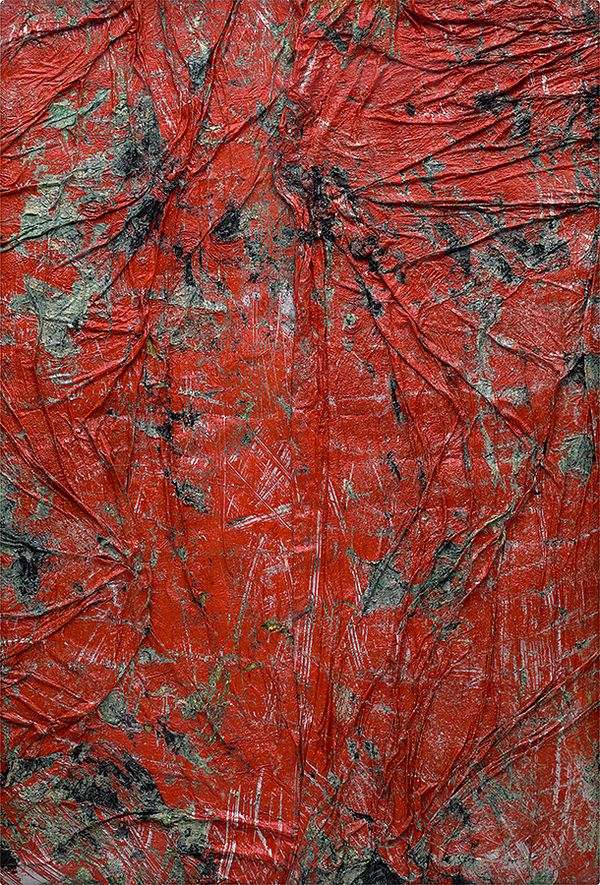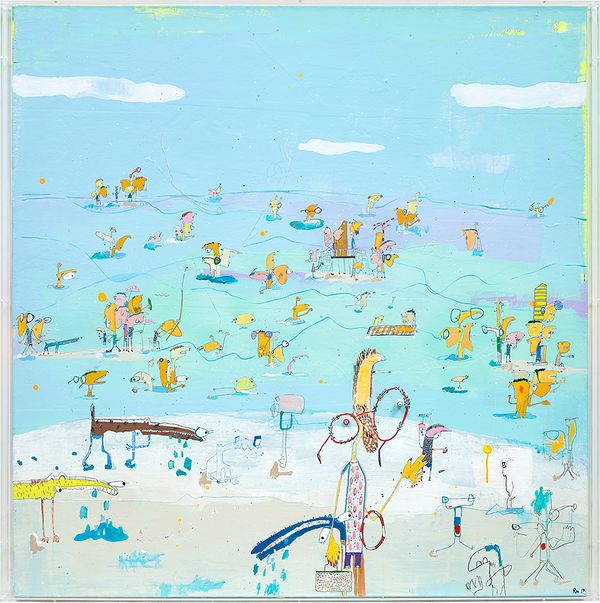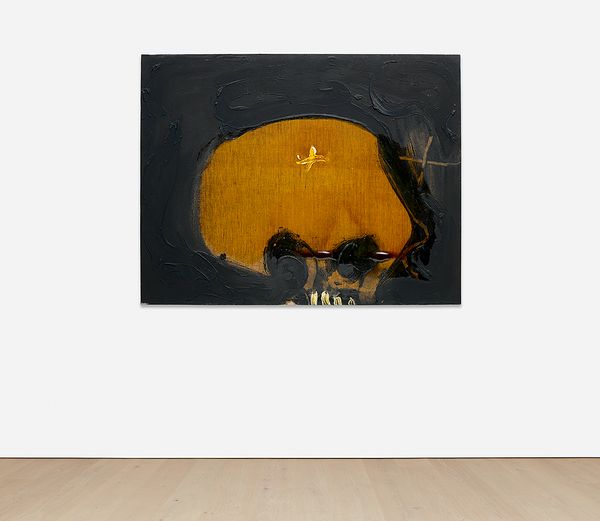Antoni Tàpies, Crani de vernís, 1988. New Now London.
On the heels of the lauded Royal Academy exhibition Spain and the Hispanic World, we follow a surprising comparative thread through works by several artists in our upcoming New Now London auction who are united across geographies and generations by their shared mother tongue of Spanish. We turn to the Catalan artist Antoni Tàpies to discover an artist who is widely considered to have pushed forward notions explored by the early Spanish avant-garde through the second half of the twentieth century and into today. Unquestionably one of the most impactful Spanish artists of recent times, Tàpies’ works have become increasingly desirable and his ideas progressively impactful.
Raised in an ardently intellectual household (his father was a Catalan nationalist and lawyer), Tàpies’ considerations of art at an elemental level have proven monumentally insightful. Associated with the Art Informel movement, he once noted, “for me, art is a mechanism, a system that makes it possible to change the spectator’s way of looking and to bring him or her closer to a state of contemplation of reality at its deepest level.”
Coming to maturity as an artist and thinker in the shadow cast by the decline of the Spanish Empire and living through the dark complexities of the Spanish Civil War and the Second World War, that contemplation of “reality at its deepest level” was for him existential. It’s unsurprising then, that in the strikingly evocative painting from 1988 Crani de vernís, the viewer is confronted with the central motif of a skull that emerges from the masterful economy of mark-making and clever use of surface layers that make up the composition.

Antoni Tàpies, Crani de vernís, 1988. New Now London.
“…for me art has to perturb, to obligate the viewer to discussion.”
—Antoni Tàpies
The art historical connotations of the Vanitas still life and Momento Mori challenge the viewer to consider those typical associations of the fragility of life and thus the premise of death, as well as the religious notions around the futility of the pursuit of earthly wealth (heightened by his placement in the work of his characteristic cruciform insignia, embedded almost as a kind of coded message). The remarkably sparse, almost “late style” (to echo Adorno) of the work coupled with a rich surface texture that calls attention to the painting’s materiality, encourages the viewer to reconsider these art historical associations, leading us to a moment of broad recontextualization and questioning. As Tàpies remarked of his practice, “I see that by barely suggesting things the association of ideas I like to provoke in the spectator widens.”

Angel Otero, Untitled (SK-SU), 2014. New Now London.
Some sensibilities present in Tàpies’ work and thought can be considered in the context of Puerto Rican painter Angel Otero’s practice — the intersection of memory and reality, and the implications of a seemingly coded image or texture. The present work showcases Otero’s characteristic practice in employing what he has called “skins” or “oilskins.” This metaphor is embodied in the physical result of the process, which the artist begins by painting onto plexiglass before scraping off the semi-dry paint and placing the resulting “skin” onto the canvas, creating an ever-evolving texture. The result as seen in this work is an obfuscated three dimensional linearity that flows across the canvas, almost reminiscent of blood vessels.
“I wanted each skin to feel the way individual brush strokes feel to me when I’m painting”
—Angel Otero
Through his painterly process, the artist revisits memories of his childhood in Puetro Rico, often indirectly referencing his grandmother. However, Otero understands the fallibility of memory, instead engaging in this practice to come closer to a current reality. He notes: “I’m not trying to reinterpret a specific memory, but rather embrace the idea of it.”

Oscar Murillo, Movement and rhythm between one place and another #8, 2013. New Now London.
A similar approach to a coded imagery can be seen throughout the five seemingly disparate canvases of Colombian artist Oscar Murillo’s Movement and rhythm between place and another #8. This 2013 work, executed around the time of his early-career inclusion in a major group show at MoMA, seems to explore certain longtime preoccupations for the artist — migration, trade, family, and settlement. The artist employs a variety of mediums in the work, including oil, oilstick, graphite, spray paint, concrete dye, tape, dirt, and thread. It is the use of thread and line in the work that creates a continuity between each section. The three dimensionality here lends an almost cartographic nature to the surface, which may reflect Murillo’s many travels. His family immigrated to London from Colombia when he was 10, and his recent practice has included methods of working on flights (the idea of treating any space as a studio while transient is an act he has called “flight mode”).

Oscar Murillo, Movement and rhythm between one place and another #8 (detail), 2013. New Now London.
The striking assemblage of materials in Berlin-based Argentinian artist Tomás Saraceno’s Galactic Cumulus include stainless steel threads that appear as a sort of mechanical network, reminiscent of a vascular system or spider webs. This is intentional, as the artist, whose work engages the community and environment to provoke considerations of the fragility of the ecosystem, has studied spider webs and is fascinated by their use as acoustic communication tools among arachnid communities.

Tomás Saraceno, Galactic Cumulus, 2012. New Now London.
The use of plastic mirror panels in Galactic Cumulus encourages viewers to understand their place in it, which communicates the artist’s conception of a unified reality in which all ideas, beings, and spaces are interconnected. Saraceno’s goals with his work can be viewed in the context of Tàpies’ notion of shifting a viewer’s way of seeing to bring them closer to a questioning and understanding of reality. However, Tàpies’ conviction can also be considered in the context of more graphic works, including three works by younger Spanish-speaking artists who each present canny alterations of well-known forms to challenge viewer’s perceptions of reality. For example, the Spanish artist Rafa Macarrón possesses a masterful understanding of the human form owing to his background in Physiotherapy, yet he employs this knowledge to depict deformed human-like figures that beg us to question our way of seeing. As he has said, “I invite the viewer to look at things differently […] I’d like the viewer to relate to my interpretation of reality and what surrounds us.” The self-taught artist relates this amalgamation of form in his characters to his admiration for Jean Dubuffet and the Spanish painter Alfonso Fraile.

Rafa Macarrón, Un día en la playa, 2017. New Now London.
A sort of deformation of the human figure is also present in the work of Spanish artist Cristina BanBan. She often sources ideas from personal experiences and memories and frequently includes self-portraits in her work. The motivation for her practice is exhaustive, as she once said, “I grab whatever is in or around me — memories, feelings, a dream, a sentence from a book I’m reading, a conversation with a friend, or a situation with a lover. Everything becomes content for a painting.”

Cristina BanBan, Mother and Son, 2018. New Now London.
Admitting that hands are her favorite part of the human body, BanBan’s characteristic style often includes hands or other limbs that are enlarged to express her subject’s inner emotional reality. These forms create an aesthetic dissonance with the more proportional figuration in the other areas of her figures. A similar approach can be seen in the work of Spanish artist Edu Carrillo, whose highly stylized figuration is represented here in Painter Smoking, which ostensibly presents the artist’s own impossibly large hand at work to challenge our sense of perception.

Edu Carrillo, Painter Smoking, 2022. New Now London.
What unifies these more figurative works is a play on our expectations of form as a means to share their artist's own sense of reality. Yet all seven of these artists are connected not only by a shared language, but they appear to be unified in their agreement with a crucial idea offered by Antoni Tàpies — that “profundity is not located in some remote, inaccessible region. It is rooted in everyday life.”
Discover More from New Now London >
